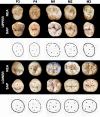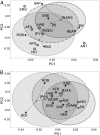No known hominin species matches the expected dental morphology of the last common ancestor of Neanderthals and modern humans
- PMID: 24145426
- PMCID: PMC3831471
- DOI: 10.1073/pnas.1302653110
No known hominin species matches the expected dental morphology of the last common ancestor of Neanderthals and modern humans
Abstract
A central problem in paleoanthropology is the identity of the last common ancestor of Neanderthals and modern humans ([N-MH]LCA). Recently developed analytical techniques now allow this problem to be addressed using a probabilistic morphological framework. This study provides a quantitative reconstruction of the expected dental morphology of the [N-MH]LCA and an assessment of whether known fossil species are compatible with this ancestral position. We show that no known fossil species is a suitable candidate for being the [N-MH]LCA and that all late Early and Middle Pleistocene taxa from Europe have Neanderthal dental affinities, pointing to the existence of a European clade originated around 1 Ma. These results are incongruent with younger molecular divergence estimates and suggest at least one of the following must be true: (i) European fossils and the [N-MH]LCA selectively retained primitive dental traits; (ii) molecular estimates of the divergence between Neanderthals and modern humans are underestimated; or (iii) phenotypic divergence and speciation between both species were decoupled such that phenotypic differentiation, at least in dental morphology, predated speciation.
Keywords: European Pleistocene; geometric morphometrics; morphospace; node reconstruction; phylogeny.
Conflict of interest statement
The authors declare no conflict of interest.
Figures



Similar articles
-
Dental evolutionary rates and its implications for the Neanderthal-modern human divergence.Sci Adv. 2019 May 15;5(5):eaaw1268. doi: 10.1126/sciadv.aaw1268. eCollection 2019 May. Sci Adv. 2019. PMID: 31106274 Free PMC article.
-
Facial morphologies of Middle Pleistocene Europe: Morphological mosaicism and the evolution of Homo neanderthalensis.J Hum Evol. 2025 Apr;201:103645. doi: 10.1016/j.jhevol.2024.103645. Epub 2025 Feb 24. J Hum Evol. 2025. PMID: 39999512
-
Evolution of middle-late Pleistocene human cranio-facial form: a 3-D approach.J Hum Evol. 2010 Nov;59(5):445-64. doi: 10.1016/j.jhevol.2010.06.005. Epub 2010 Aug 13. J Hum Evol. 2010. PMID: 20708775
-
Twentieth anniversary of Homo antecessor (1997-2017): a review.Evol Anthropol. 2017 Jul;26(4):157-171. doi: 10.1002/evan.21540. Evol Anthropol. 2017. PMID: 28815959 Review.
-
The origin and evolution of Homo sapiens.Philos Trans R Soc Lond B Biol Sci. 2016 Jul 5;371(1698):20150237. doi: 10.1098/rstb.2015.0237. Philos Trans R Soc Lond B Biol Sci. 2016. PMID: 27298468 Free PMC article. Review.
Cited by
-
Shape variation in modern human upper premolars.PLoS One. 2024 Apr 9;19(4):e0301482. doi: 10.1371/journal.pone.0301482. eCollection 2024. PLoS One. 2024. PMID: 38593117 Free PMC article.
-
Gene networks, occlusal clocks, and functional patches: new understanding of pattern and process in the evolution of the dentition.Odontology. 2015 May;103(2):117-25. doi: 10.1007/s10266-015-0208-3. Epub 2015 May 19. Odontology. 2015. PMID: 25986362 Review.
-
Discontinuity of human presence at Atapuerca during the early Middle Pleistocene: a matter of ecological competition?PLoS One. 2014 Jul 23;9(7):e101938. doi: 10.1371/journal.pone.0101938. eCollection 2014. PLoS One. 2014. PMID: 25054305 Free PMC article.
-
The human semicircular canals orientation is more similar to the bonobos than to the chimpanzees.PLoS One. 2014 Apr 7;9(4):e93824. doi: 10.1371/journal.pone.0093824. eCollection 2014. PLoS One. 2014. PMID: 24710502 Free PMC article.
-
Brain enlargement and dental reduction were not linked in hominin evolution.Proc Natl Acad Sci U S A. 2017 Jan 17;114(3):468-473. doi: 10.1073/pnas.1608798114. Epub 2017 Jan 3. Proc Natl Acad Sci U S A. 2017. PMID: 28049819 Free PMC article.
References
-
- Schwartz JH, Tattersall I. Fossil evidence for the origin of Homo sapiens. Am J Phys Anthropol. 2010;143(Suppl 51):94–121. - PubMed
-
- Stringer C. The status of Homo heidelbergensis (Schoetensack 1908) Evol Anthropol. 2012;21(3):101–107. - PubMed
-
- González-José R, Escapa I, Neves WA, Cúneo R, Pucciarelli HM. Cladistic analysis of continuous modularized traits provides phylogenetic signals in Homo evolution. Nature. 2008;453(7196):775–778. - PubMed
-
- Adams DC, Cardini A, Monteiro LR, O’Higgins P, Rohlf FJ. Morphometrics and phylogenetics: Principal components of shape from cranial modules are neither appropriate nor effective cladistic characters. J Hum Evol. 2011;60(2):240–243. - PubMed
Publication types
MeSH terms
LinkOut - more resources
Full Text Sources
Other Literature Sources
Research Materials

